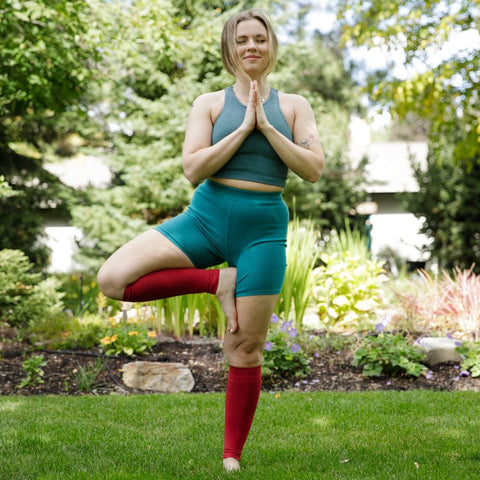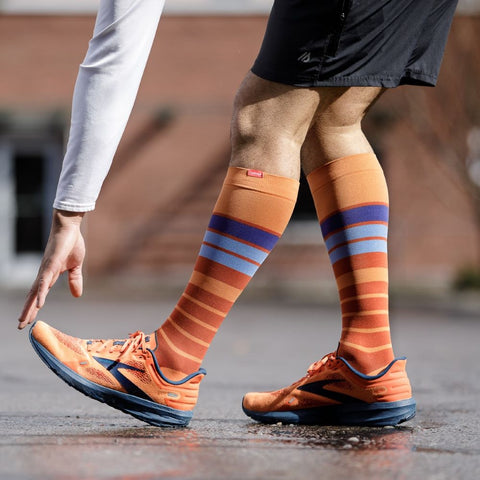The Best Compression Socks for Tennis & Why You Need Them
Written By Alecsa Stewart
Tennis is a relatively low-impact sport, but it can also open you up to injury risk. Jumping and landing repeatedly on hard ground (especially if playing indoors) and challenging your lower legs and tendons with swift turns and running can cause issues like Achilles tendonitis, shin splints, or simply swollen, sore lower limbs. Luckily, compression socks can fix that and keep you playing happily.
How do compression socks benefit tennis players and should you wear them? Through gentle massage of the lower leg muscles and boosting blood flow, compression socks and calf sleeves can make it quicker to recover in between games, reduce the risk of injury, and increase your comfort and performance.
Read on to find out the exact benefits of compression socks for tennis players and our advice on how to maximize them.
Why Tennis Players Need Compression Socks
Athletes often wear compression socks to help feel more energized and better supported while playing their sport, as well as to speed up recovery afterwards. Compression socks have their place in tennis, too.
Tennis players put a significant amount of strain on their joints and muscles. Regular running, jumping, and sliding can cause soreness and inflammation. Compression socks boost circulation in the lower legs, reducing inflammation and helping deliver oxygen and nutrients quicker to the muscles. This, in turn, reduces the time it takes to recover after every match.
Along with boosting blood flow, compression socks also provide additional muscle support. When playing tennis, legs are subjected to multiple vibrations every time the feet hit the ground. Over time, these can cause fatigue and even microtrauma in the tissues. Compression socks reduce the micro vibrations, improving stability. Thanks to this stabilizing action, they’re also recommended for tennis players returning from injury, or who are suffering from shin splints, among other problems.

The Benefits of Compression Socks for Tennis
Compression socks boost blood flow and give additional support and massage to the lower legs. These two actions are beneficial both when playing and recovering from playing sports.
Injury Prevention
A key reason to wear compression socks when playing tennis is the fact that they can help prevent a multitude of injuries. They can also be worn when recovering from some injuries like Achilles tendonitis or stress fractures, thanks to the added support to the joints.
Additionally, compression socks help reduce the impact of muscle oscillations from multiple landings. They also boost blood flow in the lower legs, reducing the risk of any circulatory conditions such as blood clots or varicose veins. Finally, because of how they support and massage the tibia and calf muscles, they can help reduce the risk of shin splints or calf sprains and strains.
Reduced Muscle Fatigue
The tight grip of compression socks onto a tennis player’s lower leg muscles has also been credited with reduced fatigue. Supporting blood flow to the muscles also means that they get oxygen and nutrients delivered quicker, which reduces the time it takes to recover after a hard effort. Reduced soreness and fatigue mean that you can train again sooner, also improving performance.
Shorter Recovery Times
After a hard workout, wearing compression socks helps relieve the immediate soreness in the legs, creating a feeling of lightness and a pleasant massage. Moreover, stimulating blood flow into the lower legs, compression socks contribute to reducing the time it takes for muscles to replenish and heal. This leads to shorter recovery times - one of the demonstrated key benefits of compression therapy.
Enhanced Overall Comfort
Wearing compression socks creates a feeling of support and ongoing massage in the lower legs. This can be extremely soothing before or after playing a game of tennis. It’s also psychologically beneficial during a game: that feeling of added support boosts self-belief, leading to better performances.
Moreover, compression socks have been proven to reduce the risk of legs and ankles becoming swollen and/or painful because of fluid retention (such as blood pooling). If you’re headed to a tennis game after a long day at the office, they can be instrumental in helping you feel light on your feet and avoiding swelling and discomfort.

How to Wear Compression Socks for Tennis
While you can wear compression socks on the tennis court, at home, preparing for a game, or during recovery, you may be wondering what the benefits are in each context and how to maximize the effectiveness of compression on your muscles and joints. Here are some of our best tips.
When Should Tennis Players Wear Compression Socks?
Wearing compression socks or calf sleeves before a match boosts circulation in the lower leg muscles, reducing any inflammation and helping “warm up” before you play. This is great for reducing the risk of calf sprains during a match. It’s also beneficial to wear compression socks during the day before you step onto the tennis court, especially if you’re traveling or if you’re sitting down for long periods of time.
During a tennis match, compression socks support the lower limbs. They have a tight grip on the ankles, which can feel reassuring when you’re coming back from injury. They also help deliver more oxygen and nutrients to the muscles through their blood flow-boosting action, which can delay fatigue and soreness.
Finally, after a game, compression socks massage the muscles and stimulate blood circulation towards sore, inflamed parts of your body. This provides momentary relief, while also helping to repair muscle damage and get you ready to play again sooner.
As you can see, you can get benefits from wearing compression garments at any time of the day, during a tennis match or not. It’s a matter of personal preference at which of these stages you decide to rely on your compression socks or sleeves.

How Long Should Tennis Players Wear Compression Socks?
To feel relief from swelling, muscle soreness, or inflammation, compression socks need to be worn for at least a few hours at a time. However, the way tennis players respond to compression therapy is highly personal. It’s also influenced by factors like overall fitness, health conditions, and level of effort.
The important thing to note is that compression socks apply a gentle pressure to the lower limbs as soon as they’re worn. This means that most people will feel a pleasant massage and a soothing action from the socks immediately. When it comes to reduced inflammation or muscle soreness, this can take a few hours to be noticed.
Proper Care and Maintenance
It’s important to take good care of compression socks so they can stay effective for as long as possible. Tennis players should wash their socks after every match (or after every wear outside of the tennis court). Most compression socks should be left to dry naturally, so there is no damage to the fabric.
You shouldn’t pull on your socks to avoid damaging the fibers and reducing their tightness. Well-fitting compression socks should be easy to put on and remove, but you should be careful and follow a specialist guide if you have any doubts.
The Best Compression Socks for Tennis Players
Choosing the best tennis compression socks isn’t difficult, but you need to consider a few factors that come into play. Here are the key things to understand to make the best choice.
Types of Compression Socks to Consider
For tennis players, full-length compression socks that reach under the knee are the most beneficial. Graduated compression socks are tighter around the ankle and slowly reduce the pressure as they climb up the calf, which stimulates upwards blood flow. This is what keeps swelling and inflammation down. Knee-high socks are also good for supporting the ankles and reducing impact on the shins and calf muscles.

Another good option are calf sleeves. These tubular garments reach from above the ankle to below the knee, gripping the calf muscles and shins. They offer uniform compression - so there’s the same level of pressure applied throughout. A benefit of calf sleeves for tennis players is that they can be paired with a different choice of socks for the feet - e.g., a particular material or style that you may find works well for you. But remember: calf sleeves don’t act on the ankles, so there is still a risk of swelling in that area when you wear them.
Understanding Size and Fit
Size is essential for ensuring your compression socks are effective. They need to be tight enough to stimulate blood flow and massage the muscles, but not so tight that they become uncomfortable. To ensure best fit, check out our sizing guide and start by measuring your calf circumference.
It may take a short while to get used to wearing compression socks - this is why they can seem too tight at the start. We recommend starting by wearing a new pair for a few hours at a time, until you’re used to them. Then, you can gradually extend the length of time you keep them on for.
Choosing the Right Compression Level
Compression socks also come in different levels of compression. This is measured in mmHg and shows how tight they will actually be on the legs.
For playing tennis and for everyday wear or recovery, moderate compression socks (15-20 mmHg) will work perfectly for most people. However, if you suffer from a circulatory health problem or have a condition that may cause your doctor to advise wearing more advanced compression socks, you can opt for 20-30 mmHg.
Material and Fabric Options
One final element of well-fitting, effective compression socks for tennis is the material. For tennis players, breathability is essential - you don’t want sweaty feet in those tennis shoes! Moisture-wicking materials like merino wool can be perfect compression sock fabrics since they also allow feet to remain dry and are excellent at regulating temperature (so you can avoid cold feet in winter, too!).
Another good choice for playing tennis is nylon or moisture-wick nylon. These compression socks are sleek and tight, but also very flexible, which makes them ideal for exercising in. They keep feet free of blisters or rubbing, while also letting them breathe adequately.
Finally, for recovery or everyday wear, you can opt for cotton compression socks. They come in a large variety of styles and designs, making them colorful, stylish accessories, too. Cotton is comfortable and soft for all-day wear, but it’s not a great material for moisture wicking, which is why we recommend switching to merino wool or nylon for playing your next tennis match.



















I like your socks, like your website
Leave a comment